Decimated Sudan sugar industry faces bleak future
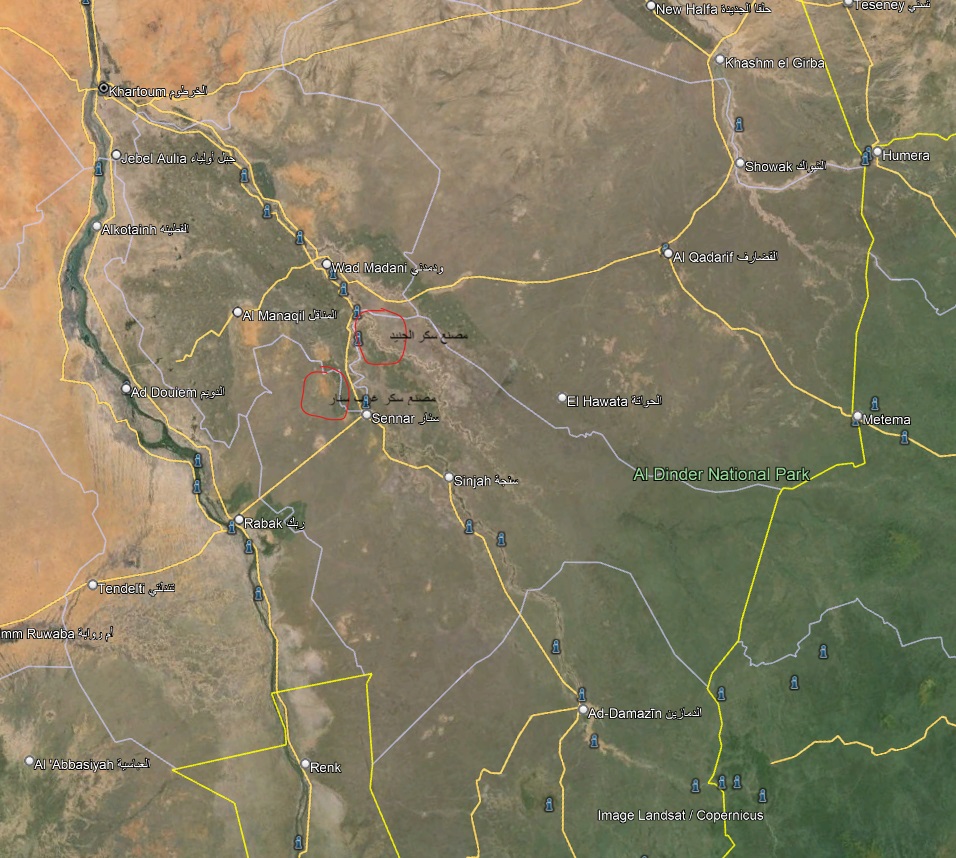
Map showing sugar factories controlled by the Rapid Support Forces (Google Maps)
Like other sectors of the Sudanese economy and its industrial institutions, the sugar industry has not been spared from the war that erupted on 15 April 2023. The devastation has particularly affected sugar production facilities, especially after the conflict spread to the states of El Gezira, White Nile, and Sennar, where five of the six operational sugar factories were located at the onset of the war. Two of these factories have been directly hit and sustained losses due to the war, while the remaining four are struggling with numerous challenges that hinder their normal operation.
Sugar is a vital consumer good in Sudan, with one of the highest per capita consumption rates globally. The combined production of the six sugar factories in recent years averaged around 427,000 tonnes, whereas their maximum production capacity should exceed 750,000 tonnes of white sugar. Pre-war annual consumption was estimated at around 1 million tonnes, resulting in a yearly shortfall that has been covered through sugar imports and local repackaging.
These sugar factories also produce other financially beneficial products such as methanol, alcohol for medical purposes, and animal feed. Additionally, the agricultural cycle, alongside sugarcane, incorporates various grains, vegetables, and poultry farming. This sector employs many seasonal workers for planting and harvesting sugarcane, as well as skilled and professional workers in industrial operations.
The sugar factories have become targets for the Rapid Support Forces (RSF) due to their fuel reserves for agriculture, energy generation, and their large fleets of agricultural machinery, such as tractors and transport vehicles, which can be repurposed for military use. Furthermore, the sugar stocks themselves are enticing for seizure and trade. As such, the factories have been sites of fierce battles between the RSF and the Sudanese Armed Forces (SAF).
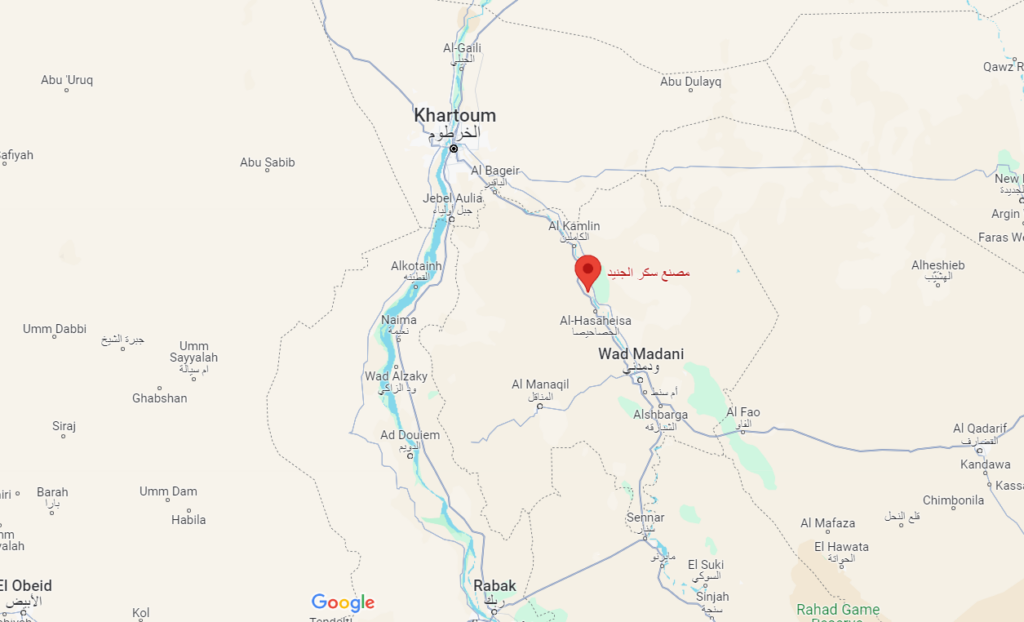
El Junaid Sugar: The first factory plundered
The first sugar factory attacked was El Junaid during the RSF invasion of El Gezira. Reports indicated that the RSF stormed the El Junaid Sugar factory on 18 December 2023, looting all the sugar stockpiles, cars, tractors, and some office equipment. Although there are no precise estimates of the losses incurred, it is certain that the factory’s prolonged shutdown, exceeding a year, will pose significant difficulties in resuming operations and sourcing spare parts.
El Junaid sugar factory, the first of its kind established in Sudan in 1962, sits on the eastern bank of the Blue Nile, about 120 kilometres south of the capital, Khartoum, with the nearest large city being Rufaa, which the RSF seized on the same date. The factory and its farm cover an area of 20,000 acres dedicated to sugarcane cultivation. It was designed to produce 66,000 tonnes of white sugar, but recent years have seen production drop to around 20,000 tonnes. The factory faces significant issues related to outdated machinery, the need for expensive spare parts, high agricultural operation costs, electricity shortages, a lack of necessary resources, and low worker wages.
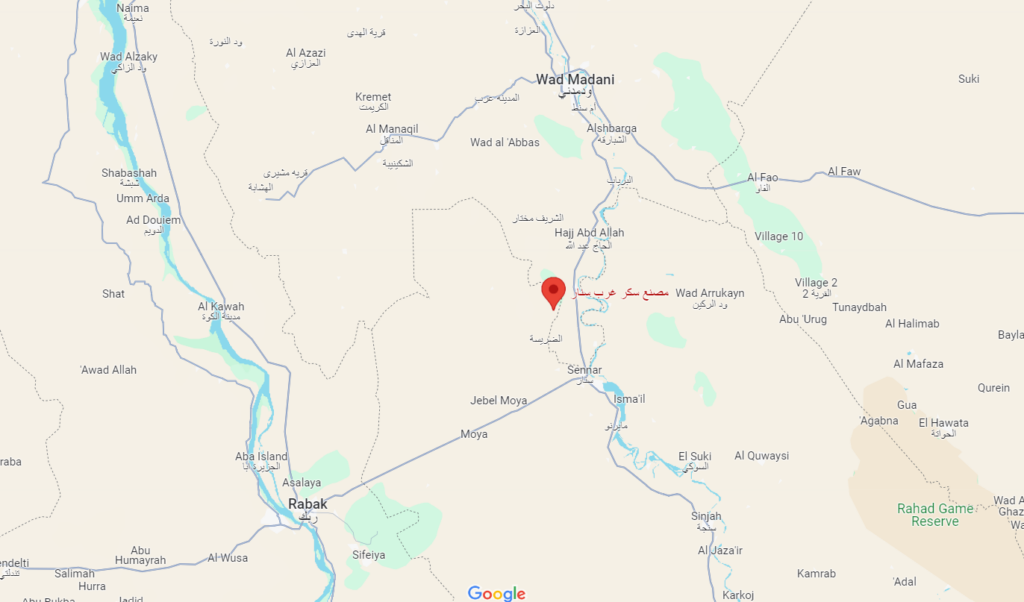
West Sennar Sugar factory
After advancing into Sennar state from El Gezira, the RSF attacked SAF positions around the West Sennar Sugar factory, forcing them to withdraw. On 26 December, the West Sennar Sugar factory was attacked by raiders who looted the sugar stores and vehicles, though it is reported that this occurred under the watchful eyes of the RSF. On the same day, military aircraft bombed the factory and surrounding areas, causing losses that have not been independently assessed. The next day, the RSF attacked the “Sugarcane Research Centre,” one of Sudan’s most important research facilities, looting its contents. A SAF-led counterattack on 2 March 2024 to reclaim the factory was unsuccessful.
The West Sennar Sugar factory, located 300 kilometres south of Khartoum on the western bank of the Blue Nile and just west of the city of Sennar, was established in the 1970s during the May regime over an area of 35,000 acres to produce white sugar.
Like other sugar factories, West Sennar Sugar factory has faced significant challenges, reducing its production to about 40,000 tonnes of sugar. Experts believe the factory will need a complete overhaul post-war due to its prolonged shutdown, outdated equipment, and loss of operational expertise.
Factories yet to be affected by the war
Four of Sudan’s six sugar factories remain safe from destruction and looting due to their current locations outside conflict zones, specifically Halfa New Sugar factory, Kenana Sugar factory, Assalaya Sugar factory, and White Nile Sugar factory. One of these factories, Halfa New Sugar factory, is in Kassala state, which has so far remained distant from military operations, while the other three are in White Nile state, with their agricultural lands extending into Sennar state.
These three factories are the largest and most modern, using relatively advanced equipment and machinery: Kenana Sugar factory, Assalaya Sugar factory, and White Nile Sugar factory. The battles are approaching these factories from three directions despite the RSF’ ultimate goal being the city of Kosti, the headquarters of SAF’ 18th Infantry Division. The fronts are moving from north to south along the White Nile from Omdurman and Jebel Aulia towards Duwaim and Rabak, from south to north from Sennar state towards Kenana Air Base and Rabak, and from east to west from Jebel Moya towards Rabak.
Kenana Sugar factory
Established in the mid-1970s, Kenana is the largest sugar factory in Sudan, covering a vast area of 165,000 acres spread between White Nile and Sennar states. It is designed to produce around 400,000 tonnes of high-purity white sugar for export, but recent years have seen a decline to about 250,000 tonnes annually on average due to a halt in capital investments necessary for production expansion.
The factory is located 21 kilometres southeast of Rabak and 270 kilometres south of Khartoum. It is also close to Kenana Air Base, the third most important airbase for SAF after Wadi Sayedna and Merowe, given the RSF control over several airports and disruption of operations at other bases.
Experts fear that any attack on the factory and surrounding areas could result in losses amounting to billions of dollars and the flight of foreign investments, as Kenana Sugar factory is a model of joint investment between foreign and local capital and the Sudanese government.
Assalaya Sugar factory
Opened in 1980, Assalaya Sugar factory is located 280 kilometres south of the capital, Khartoum, over an area of 35,000 acres with a production capacity of around 110,000 tonnes annually. However, the factory has faced significant issues in recent years, including spare parts shortages, electricity problems, and a reduction in its agricultural area, now limited to 13 acres, with average annual production falling to around 35 tonnes of sugar. Assalaya Sugar factory would be at immediate risk if the city of Rabak, the capital of White Nile state, were attacked by the RSF, as it lies just five kilometres north of Rabak.
White Nile Sugar factory
Debates surrounding Sudan’s sugar industry often centre on the White Nile Sugar factory, which has been mired in controversy since its inception. The factory’s construction faced numerous problems, inflating its cost to around $1 billion, and there were widespread allegations of corruption involving senior figures in the now-defunct National Congress Party (NCP). Furthermore, the factory’s initial operations were hindered by American companies, bound by sanctions at the time, refusing to supply essential operating software for the machinery and equipment. Completed in 2003, the factory is located on the eastern bank of the White Nile, 150 kilometres south of Khartoum, and covers an area of 165,000 acres. It was designed to produce up to 400,000 tonnes at full capacity and approximately 125,000 tonnes in its early operational stages.
Halfa New Sugar factory
The second sugar factory established in Sudan in 1963 as part of projects to resettle the people of Halfa. It is situated 400 kilometres east of Khartoum in Kassala state, with the nearest city to the project area being Halfa New. The factory, covering an area of 40,000 acres, was designed to produce around 60,000 tonnes of white sugar but has only managed about 20,000 tonnes annually in recent years. The factory has not been directly affected by the current conflict, as Kassala state has not yet experienced military operations. However, it faces significant challenges related to electricity supply, skilled labour, seasonal labour shortages, and high production costs due to the factory’s age and the high cost of spare parts.







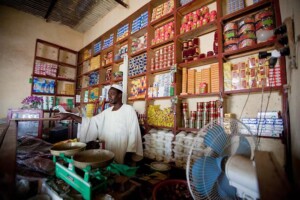
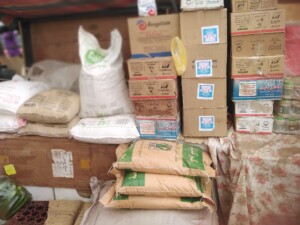
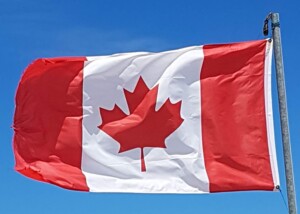

 and then
and then